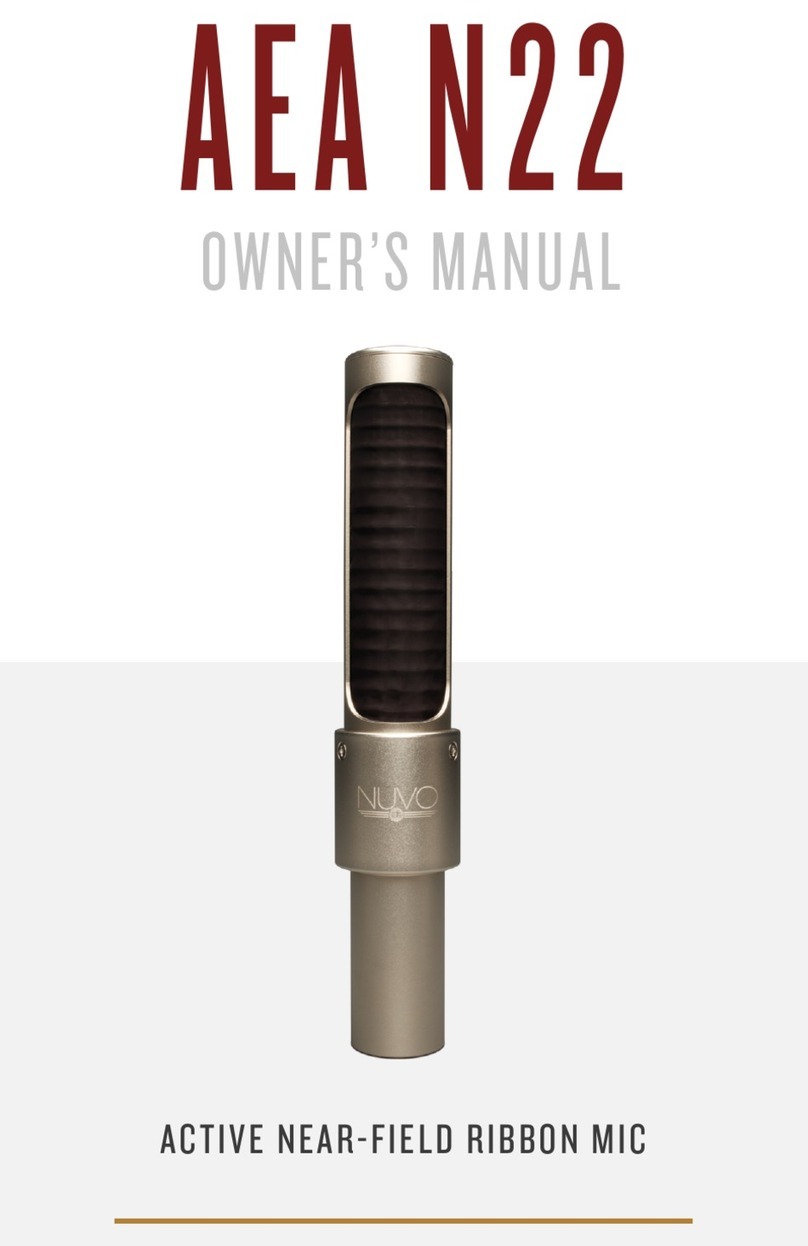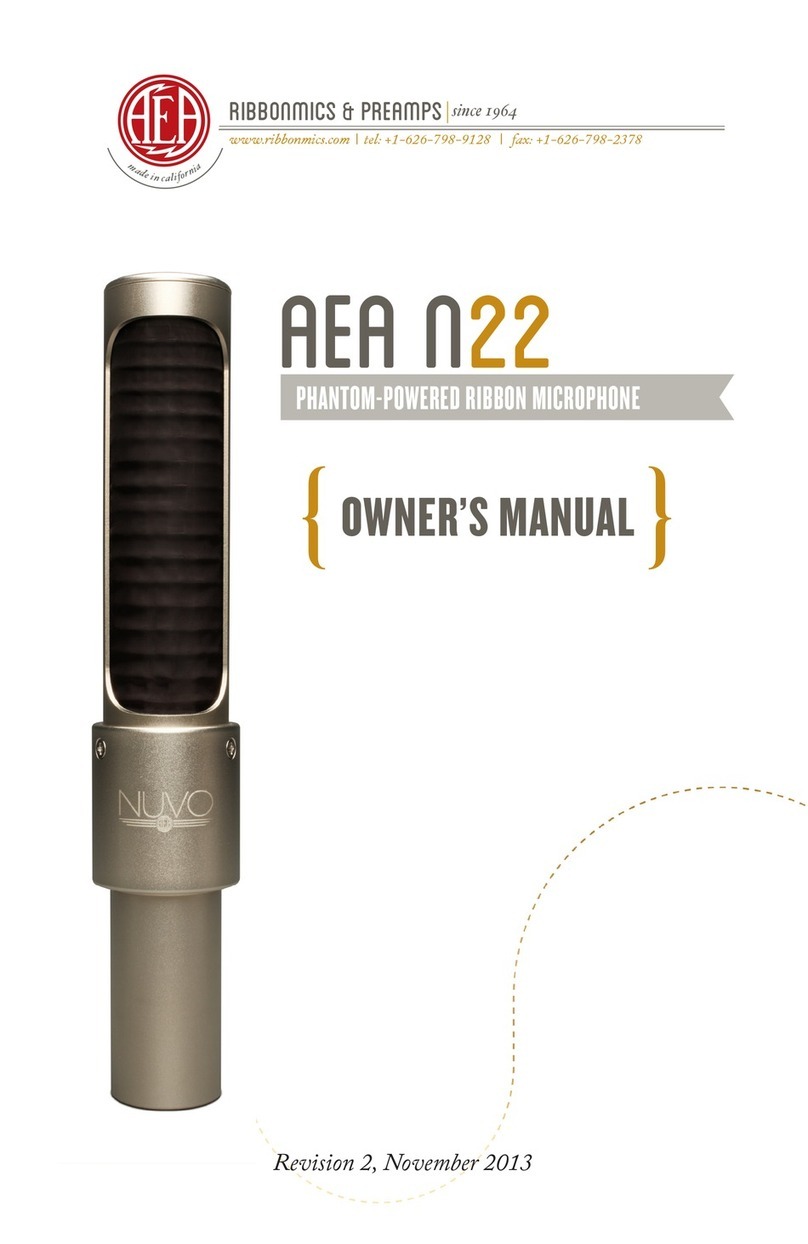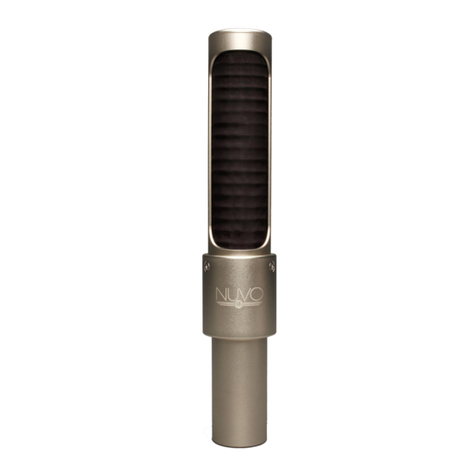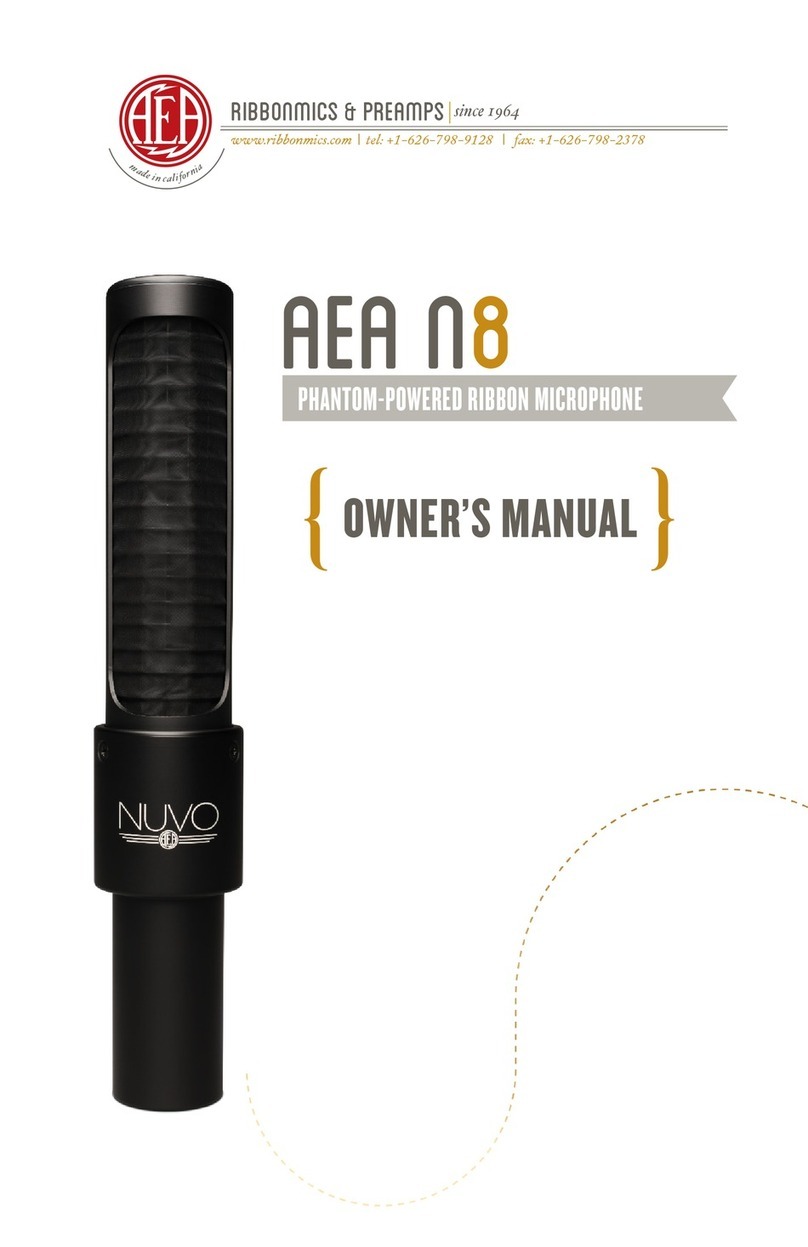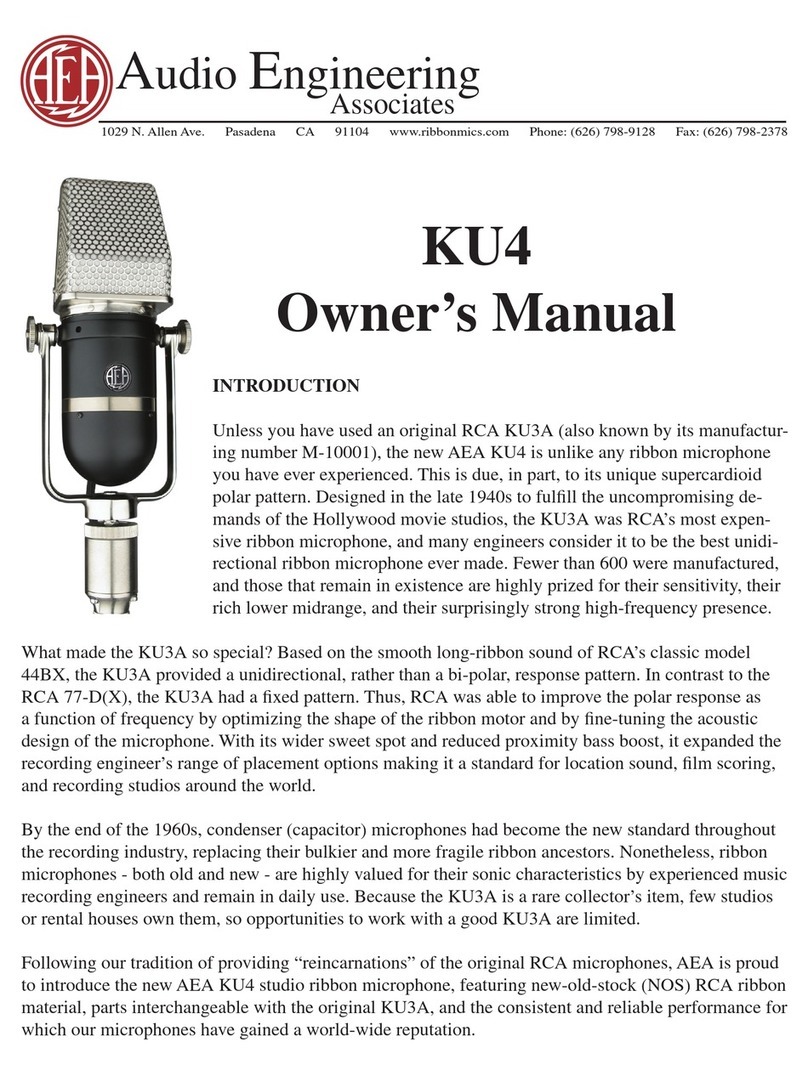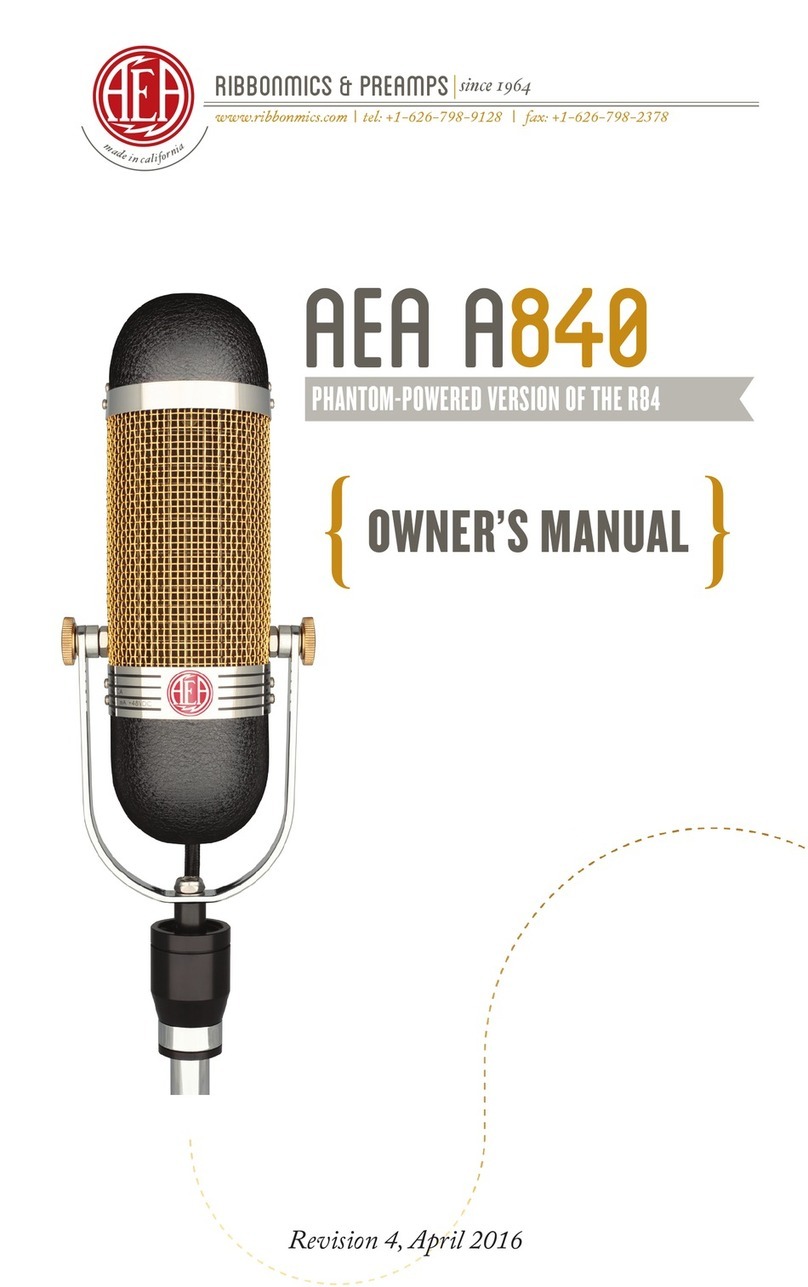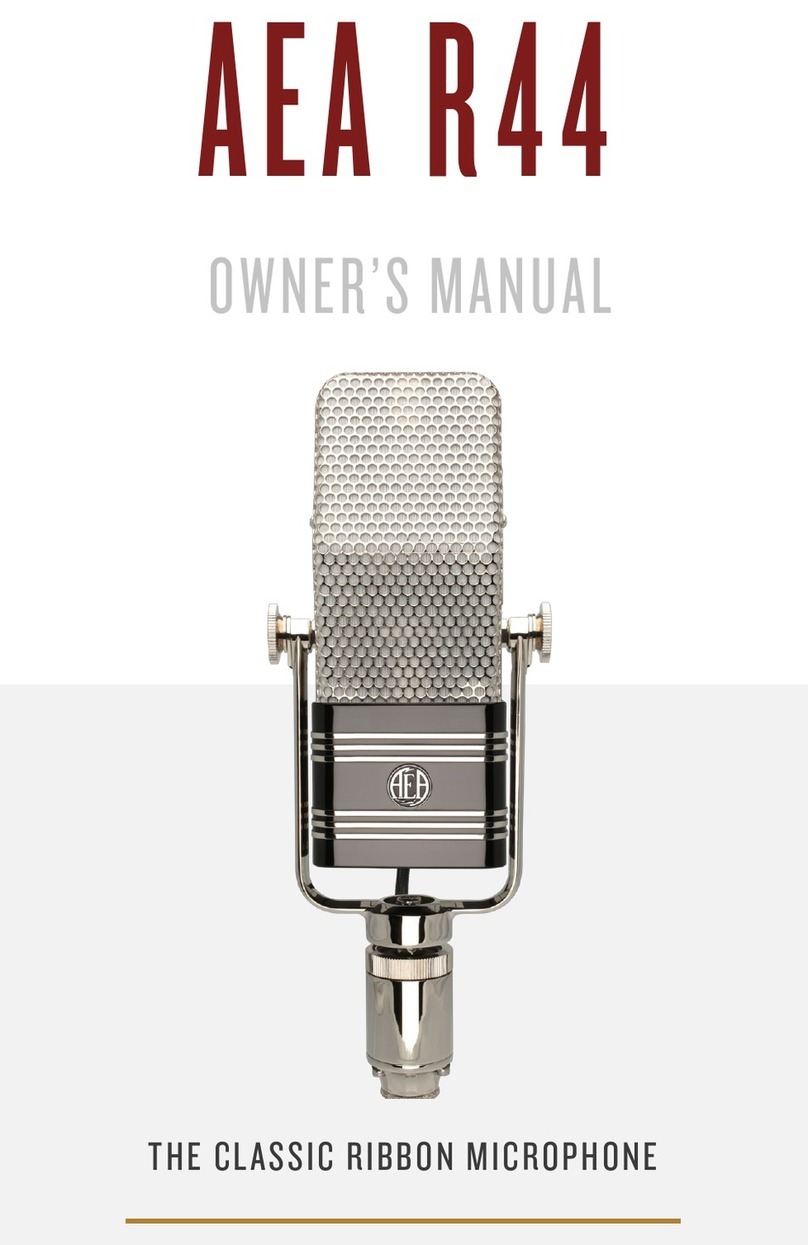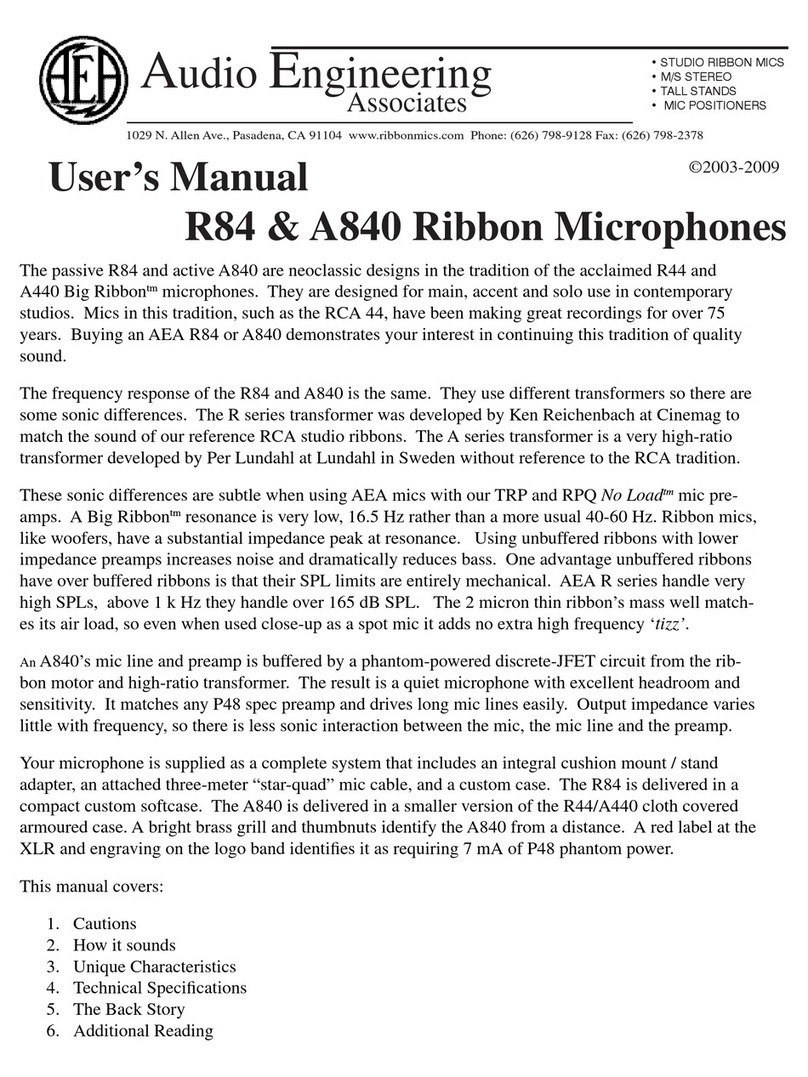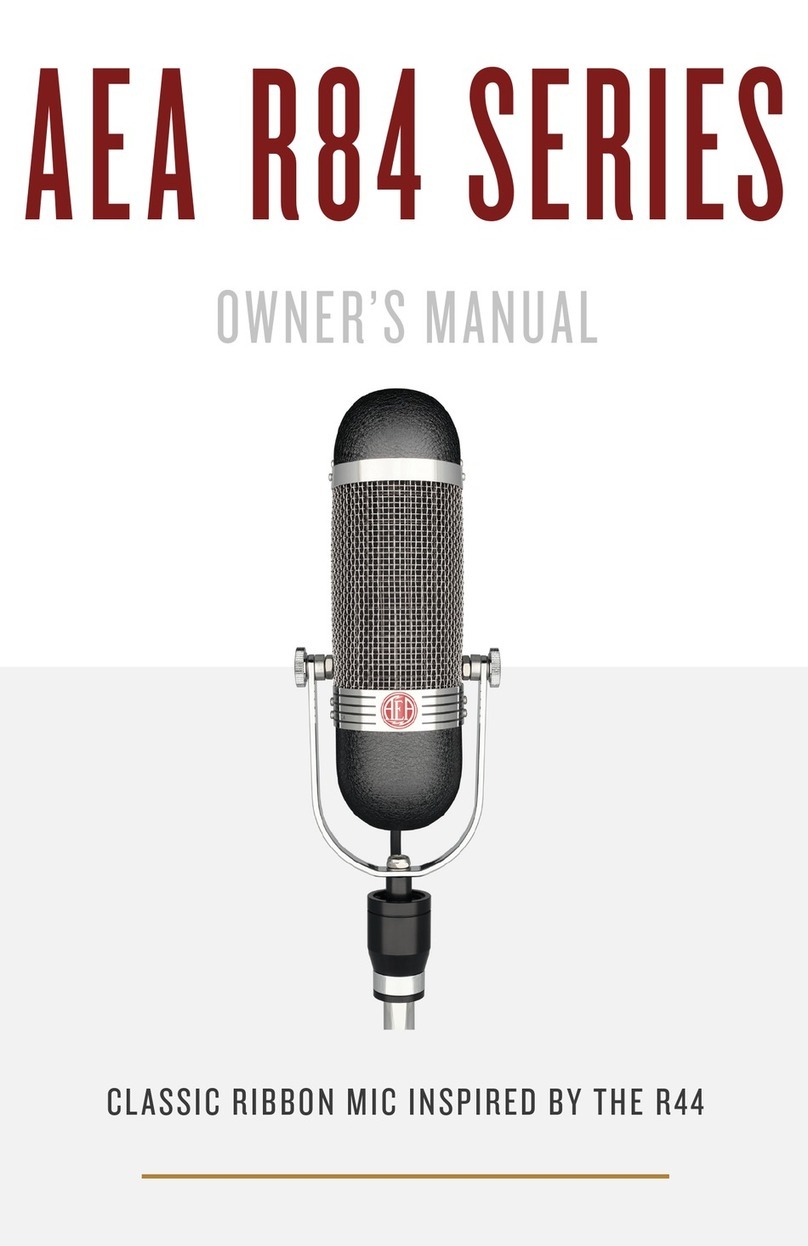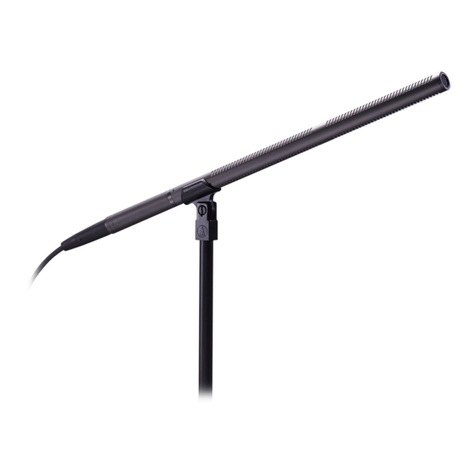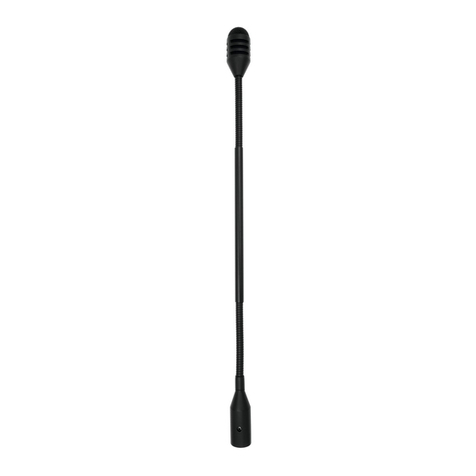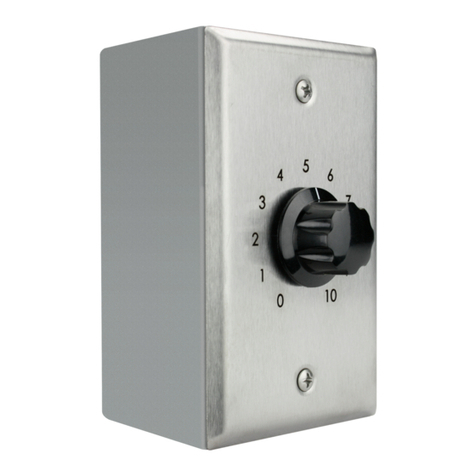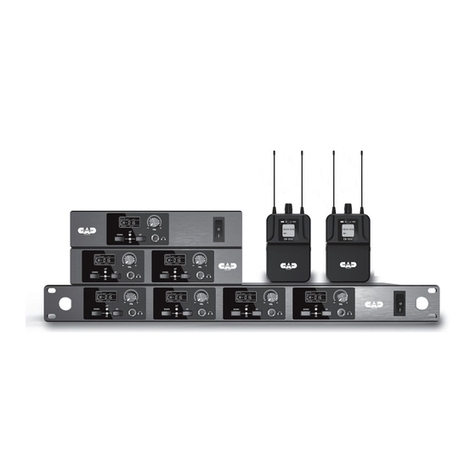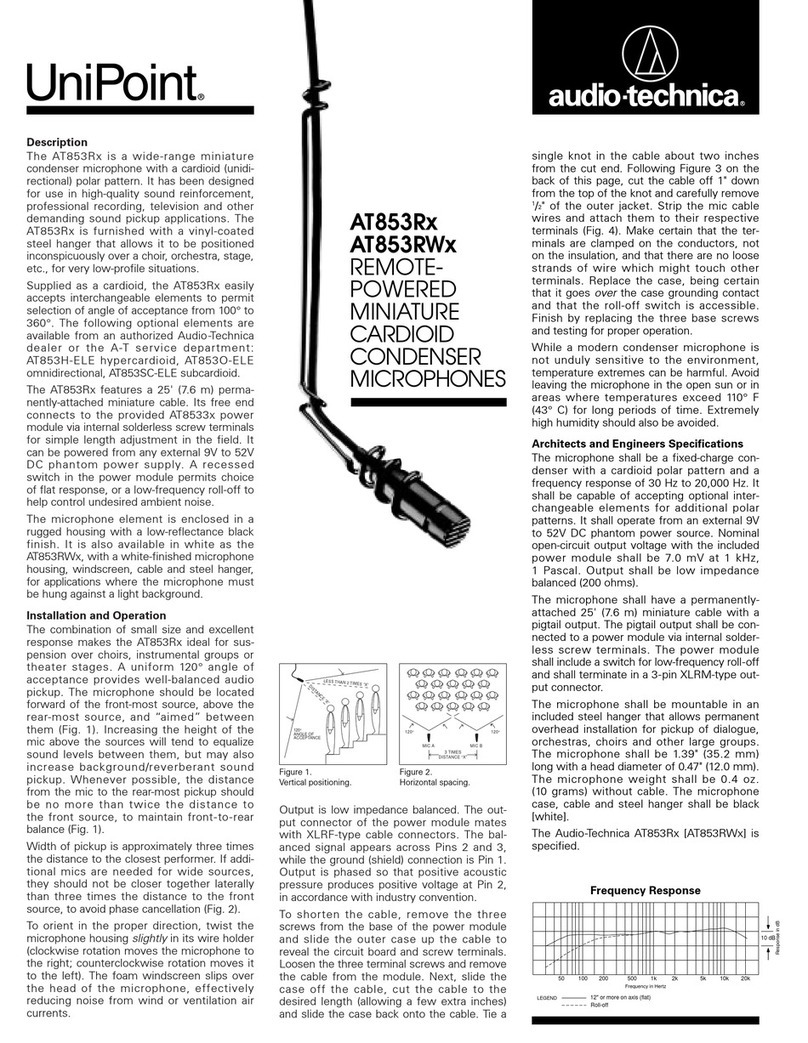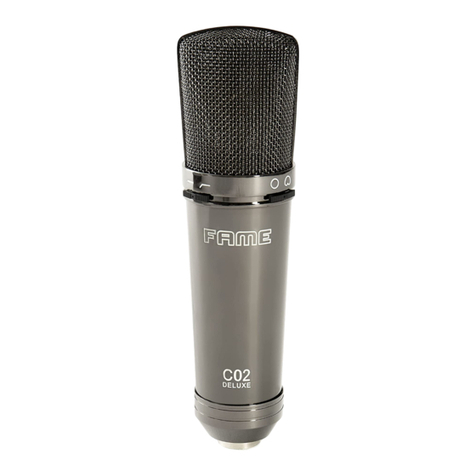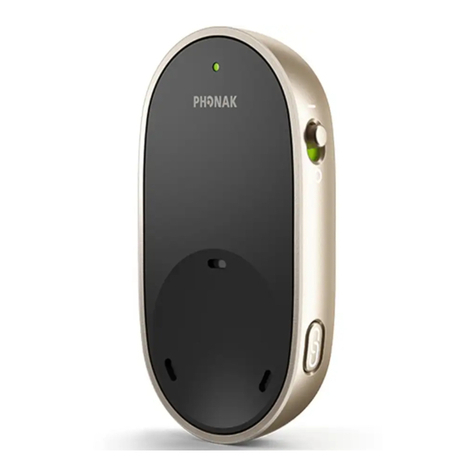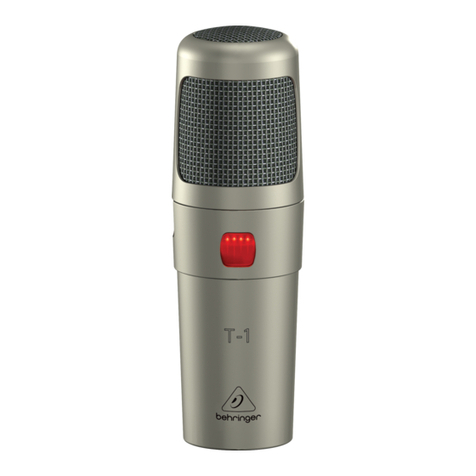AEA R88 Series User manual

FAR-FIELD STEREO RIBBON MIC
AEA R88 SERIES
OWNER’S MANUAL

WELCOME
Congratulations on your purchase of an AEA R88 Series stereo ribbon
microphone and welcome to the AEA family. There is no easier way
to track natural stereo than by using a stereo mic. The natural sound
stage and character of R88 Series' Blumlein imaging makes it a
great microphone for producing an authentic representation of a
performance in its environment. Known as the “set it and forget it mic,”
using an R88 is an excellent way to effortlessly capture the authentic
and natural sound without the hassle of a multi-mic setup. From drum
overheads and live concert recordings, to horn and strings sections,
the R88’s Blumlein system is convenient to use and delivers a phase-
coherent, accurate transient response. With sense of depth, the R88
puts the listener right with the performers in the recording room.
Your R88 Series microphone is 100% handcrafted in Pasadena, CA.
AEA is a family owned company with a small crew of skilled technicians
– most of them being musicians themselves. Proudly independent, we
still manufacture all our ribbon microphones and preamps by hand
from locally sourced parts.
We hope your microphone will capture many magical performances
that touch the heart. This manual will help ensure that you get the best
sound and longevity from your new microphone. Please become part
of the AEA community by sharing your experiences via e-mail, phone
or social media.
Wes Dooley
President of AEA
2

CONTENTS
WELCOME
INTRODUCTION
SUPPORT
GENERAL GUIDELINES
APPLICATION ADVICE
SPECIFICATIONS
2
4
4
5
8
12
3

INTRODUCTION
The R88 Series Microphones (the R88mk2 and the R88A) are
blumlein ribbon microphones consisting of two matched
bidirectional (or figure-of-8) ribbon transducers. The R88 Series
microphones use the same Big Ribbon technology and tuning
(16.5 Hz) as used in the classic R44. The passive R88mk2 uses the
same 1:28 transformer used in all of AEA’s passive mics, and the
active R88A uses the same 1:110 transformer and electronics used
in our active mics. With the great bass response and smooth top
end AEA Big Ribbons are known for, the R88 Series delivers a solid
sound stage without ever being harsh. The R88 operates with very
low distortion over a huge dynamic and frequency range, with a
capability of handling 141 dB SPL (R88A) or 165 dB SPL (R88mk2)
at 1kHz. As a far-field stereo ribbon microphone, the R88 captures
balanced sound from long distances. From 16 inches to 20 feet, the
mic retains its full spectrum and incredible low end. (The R88A is
visually distinguished by a red cable at its base)
WARRANTY
SUPPORT
Your R88 Scomes with a one-year limited warranty on
parts and labor, shipping not included. Registering
your product with AEA will extend the warranty to a
full three years.
Register your microphone at AEAribbonmics.com/
register-your-aea.
If you should encounter any problems with your microphone or
have questions regarding using your R88 series mic in specific
application, please contact our customer support team at support@
ribbonmics.com.
To talk to a live human being, call +1 (800) 798-9127, between 9:00
A.M.- 5:00 P.M. PT Monday through Friday. AEA's repair center is
located at 1029 N. Allen Ave, Pasadena, CA 91104, U.S.A.
4

GENERAL GUIDELINES
5
PHANTOM POWER
Your microphone is a valuable and important investment. Like any
piece of recording equipment or musical instrument, it requires
common sense and good basic care to keep it working properly.
Given simple, basic care, your new microphone will perform
admirably for decades.
R88 Passive Microphone
Phantom power is not required or recommended for the passive
R88. We recommend avoiding the use of phantom power with your
R88 as a general rule. With a correctly wired cable and a properly
working phantom power supply, there is actually little danger of
damaging an R88 microphone with phantom power. However,
passive ribbons such as the R88 will get hurt if ground Pin 1 is
accidentally shorted, mis-wired, or hot patched in a patch bay to
Pin 2 or 3. Using phantom power with a faulty or mis-wired cable or
a defective supply can severely stretch or break a ribbon.
Since passive ribbon microphones or other transformer-coupled
microphones are particularly sensitive to phantom-power, it is
recommended to make disengaging phantom-power before
plugging and unplugging a habit.
R88A Phantom-Powered Microphone
The phantom current draw for active AEA ribbon mics is 7
milliamps. IEC specifies P48 power which should be able to deliver
10 milliamps per input. Some USB and battery-powered audio
interfaces will not deliver this. Please check the current values
available on your unit to ensure the best performance.
Although the R88A needs a phantom power source to operate,
ensure that phantom power is turned off before plugging and
unplugging the microphone or when patching. The loud pops that
occur when the microphone is plugged in with phantom power
engaged can damage speakers, headphones, and ears.

6
AIR TURBULENCE
Never expose the microphone to strong air turbulence. Ribbon
microphones can withstand very high SPL (Sound Pressure Level)
without difficulty, but can be damaged easily by a sudden, strong
gust of air or high levels of very low frequency sound waves (like
from a kick drum or bass cabinet). This can stretch the ribbon,
causing the microphone to start sounding flabby.
To avoid possible damage, follow this simple procedure when
positioning the microphone called "The Hand Test": put the back
of your hand where the mic will be; if you can feel the motion of air
on your hand, place a pop-filter between the microphone and the
source of the wind gusts or simply pull the mic further back. When
recording kick drums or bass guitar cabinets, angle the microphone
to make sure that no wind blasts hit the microphone directly on-axis
from the front or back.
Never blow directly into any microphone to test it. Not only
does this force moisture and dirt into the microphone, strong air
movement also can stretch the ribbon and while it may not break,
it nonetheless could significantly degrade the microphone’s
performance. The ribbon in the R88 is protected by multi-layered
screens and grille cloths to provide superior wind protection.
Nonetheless, using it outdoors requires special care to avoid wind
which can damage the ribbon.
MAGNETIC STRAY FIELDS
MICROPHONE STORAGE
Keep the microphone covered when it is not in use. This prevents
potential damage to the ribbon from a strong gust of air. Place the
supplied protective slip cover over the microphone when it is not in
use. For long term storage, place the microphone in its protective
case. Minute iron particles, sometimes known as “tramp iron,” are
common within our environment. AEA ribbon microphones contain
powerful magnets that produce strong magnetic fields. These
fields can attract any ferric metal near the microphone that, if they
are small enough, can penetrate the outer screening and work
their way inside the microphone. Over time, this “tramp iron” can
build up sufficiently in the magnetic gap to rub against the ribbon
causing distortion, electrical shorts or tearing of the ribbon.

7
Ribbon microphones are fundamentally prone to picking up
strong external magnetic fields caused by light dimmers or nearby
MICROPHONE POSITIONING
WHICH PREAMP SHOULD I USE?
Always use a sturdy microphone stand. Mounting the microphone
on a strong, sturdy microphone stand with a heavy base (or tripod)
is essential. If you are using a boom, make sure that it is properly
balanced and that the tripod legs are positioned appropriately
to prevent tipping. The R88mk2 uses a weighted, integrated
shock mount and is supplied with an swivel mount adapter which
allows for easy positioning. Please ensure that the swivel mount is
properly tightened during use.
In the case of the passive R88, the preamp is critical for optimum
performance. Passive ribbon microphones generally have low
output level and require preamps that supply a high level of
gain. If the preamp you use doesn’t have enough gain, the signal
might seem too soft or noisy. We recommend using a high-input
impedance preamp with gain at least +60dB or higher.
To guarantee consistent, full-range ribbon sound, we recommend
AEA’s RPQ2, RPQ500 and TRP2 preamps, which were specially
designed for ribbon microphones. On quiet sound sources or for
distance recording, an AEA preamp is highly recommended.
power transformers. Guitar players will know this phenomenon
from single-coil pickups. Even though much attention was paid
to suppressing such sensitivity to external magnetic fields in
the design of your microphone, it is still possible that you might
encounter this problem. If you should pick up a hum, try rotating or
moving the microphone to find a spot where the hum disappears,
and try eliminating potential sources of stray magnetic fields. You
can use the microphone to find where hum is originating. Rotate
the mic for maximum interference and move it back and forth to
sense its direction.
The high-performance magnets used in AEA microphones are
incredibly strong, and a significant amount of stray magnetic field
lines surround the microphone. Avoid placing the microphone in
close proximity to hard drives, credit cards, analog tape, or any
other magnetically sensitive items to prevent any data loss.

Figure-of-8 microphones are constructed with positive polarity on
the front and negative polarity on the back. Positive pressure on the
front side of the ribbon produces a positive voltage on Pin-2, with
respect to Pin-3 on the output connector. The R88 consists of two
figure-of-8 transducers in a fixed Blumlein array.
8
A FIGURE-OF-8 MICROPHONE
A BLUMLEIN MICROPHONE
APPLICATIONS ADVICE
We actively encourage users to visit AEAribbonmics.com to
access our comprehensive collection of in-depth articles and
tutorials featuring the R88 stereo microphone, along with a
library of audio and video demonstrations of the R88 in action.
The stereo R88 is a coincident microphone system. Coincident mic
techniques use two or more transducers placed closely together.
Coincident systems have good time coherence between their
channels which means that sounds from the same source all arrive
at close to the same time. One advantage of phase coherence is
that when channels are summed to mono, there is no comb-filtering
effect.
Blumlein is a type of coincident array technique that is configured
with two vertically figure-8 pattern microphones positioned
90-degrees to each other. A Blumlein array delivers stable, in-phase

USING THE R88 IN BLUMLEIN
9
sound stages from their front and rear quadrants with an excellent
sense of depth.
The Blumlein “sweet spot” is the center point, directly in front of
the lines on the cups, where channel 1 and 2 bisect. When placing
the R88, position it so that the instruments are + or - 45 degrees
from the centerline. Align the AEA logo and vertical marks with the
instrument or ensemble you are recording.
The front quadrant (pictured above) is the positive polarity stereo
image, and the rear quadrant is the negative polarity stereo image.
This is the stereo equivalent of the difference in sound between
speaking into the front and rear of a bidirectional; the recording
sounds as if it is coming from behind you. What is physically
happening in a negative polarity recording is that the impulse that
would usually push air towards your ears is now pulling air away
from your ears.

The left and right quadrants are the “out-of-polarity” zones of the
microphone. This is because the positive lobe of one transducer
is in one channel and the negative lobe of the second transducer
is in the other channel. Sources recorded in this area make the
listener want to turn their head, because the polarity in one ear
is off. Additionally, it decreases the mono-compatibility of the
microphone, as switching to mono results in electrical destructive
interference. Prominent early reflections from these regions can
cause an ill-defined and inaccurate stereo image. Take care not to
place sound sources in these out-of-polarity zones.
Note that this out-of-polarity low frequency material from the
left and right quadrants is also responsible for the sense of
spaciousness. Nevertheless, it is best to keep the sound sources in
the front and/or rear quadrants to ensure consistency of polarity in
your signal and an accurate stereo image.
10

USING THE R88 IN M/S
The R88 also works well with Mid-Side, or M/S, recording. M/S is
worth experimenting with as it has the ability to control the stereo
width by varying the Mid to Side ratio. This is especially convenient
when recording a solo sound source where the emphasis on the
center of the stereo image.
Mid Side recording requires a "decoding matrix". There are many
popular M/S decoders available in hardware and software format.
The positive polarity of the Mid of 'M' transducer is aligned on-axis
to the primary sound source. The Side or 'S' is oriented 90-degrees
to this axis. The positive polarity of the 'S' mic is typically aimed
sound stage left. Such an orientation yields Left/Right stereo from
a sum and difference matrix where Left = Mid + Side and Right =
Mid - Side. This means that the right and left channels are hard
panned and opposite polarity copies of each other, so they sound
beautifully wide, but when switched to mono, they perfectly cancel
each other out, leaving just the “mid”.
11

PROXIMITY EFFECT
Proximity effect is a characteristic of all directional microphones; it
is a rise in low-frequency response that increases at closer working
distances. While this can be used to good effect, particularly with
low-register voices to give them an enhanced richness and depth,
the potential trade-off is reduced articulation or clarity that can
result from the masking effect on the treble due to “excessive” bass
boost.
As a stereo far-field ribbon microphone, the R88 was designed
to capture balanced sound from long distances. Sound sources
should be measured in feet rather than inches away from the mic.
From 16 inches to 20 feet, the mic retains its full spectrum and
incredible low end. When positioned closer than 16 inches, the mic
adds proximity effect. When carefully used, this proximity effect can
beef up thin sounds — either voices or instruments.
12
(graph is a visualization, not a measurement)

SPECIFICATIONS
Operating Principle:
Directional Pattern:
Frequency Range:
Polarity:
Polar Response
Horizontal:
Vertical:
Transducer Element Material:
Thickness:
Width:
Length:
Microphone Dimensions
Height:
Width:
Weight:
Shipping weight:
Connector:
R88 Passive Microphone
Maximum SPL:
Sensitivity:
Output Impedance:
Load Impedance:
Phantom Power:
R88A Active Microphone
Maximum SPL:
Sensitivity:
Output Impedance:
Load Impedance:
Phantom Power:
Pressure gradient transducer
Bidirectional
20 Hz to 20 kHz
Pin 2 and 4 high for positive pressure at the
front of the microphone.
Level changes with angle, frequency re-
sponse is consistent, -35dB null at 90º /
270º
Level changes with angle, reduced HF
response above and below 0º / 180º, -25
dB null at 90º / 270º
Aluminum corrugated ribbon
1.8 µm
0.185 in (4.7 mm)
2.35 in (59.7 mm)
15 in (38.1 cm)
3.9 in (9.9 cm)
2 lb 9.8 oz (1.19 kg)
5 lb 3 oz (2.36 kg)
XLR-5M, includes breakout cable - 2 XLR-3M
165 dB SPL (1% third harmonic > 1 kHz)
2.5 mV/Pa (-52 dBV) into unloaded circuit
270 Ω broadband
1.2 kΩ or greater
Not required or recommended
141 dB SPL
7.4 mV/Pa (-42.6 dBV)
92 Ω broadband
1.0 kΩ or greater
P48 phantom power, 7mA
Accessories Included:
Storage case, swivel adapter,
custom protective mic sleeve, user manual
R88 Breakout Cable Extensions are available for
purchase on our website.
13

3.87
15.04
3.87
14
FIGURE-OF-8 POLAR PATTERN

FREQUENCY RESPONSE
15
Data below 200 Hz omitted due to measuring room restrictions.
0 dVB is equivalent to 2.5 mV/Pa (-52 dBV) for the R88mk2 and 7.4 mV/Pa (-42.6 dBV) for the R88A at 1kHz
Normalized to 0 dB at 1kHz. 1/3 octave smoothing

AEARIBBONMICS.COM | @RIBBONMICS | [email protected] | (800) 798-9127
This manual suits for next models
2
Table of contents
Other AEA Microphone manuals
